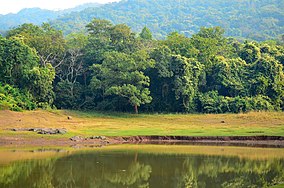Dalma Wildlife Sanctuary
| Dalma Wildlife Sanctuary | |
|---|---|
 | |
| Location | Jharkhand, India |
| Nearest city | Jamshedpur |
| Coordinates | 22°54′15″N 86°12′59″E / 22.90417°N 86.21639°E |
| Area | 195 km2. |
| Established | 1976 |
| Visitors | NA (in NA) |
| Governing body | Department of Environment, Forest and Climate Change, Government of Jharkhand |
| Website | http://www.forest.jharkhand.gov.in/ |
Dalma Wildlife Sanctuary is located 10 km from the city of Jamshedpur in the Indian state of Jharkhand. It was inaugurated by Sanjay Gandhi in 1975. It is a notable wildlife sanctuary and contains significant population of Indian Elephants.[1][2]
Geography
Dalma Wildlife Sanctuary is situated around the Dalma Hills. Dalma Wildlife Sanctuary is a much larger area starting from Chandil to 40 km east. The sanctuary covers around 195 km2.
It is about 100 km from the capital city Ranchi, and 15 km from the steel city Jamshedpur. The wildlife sanctuary runs parallel to the NH-33 with hills as high as 915 ft. from sea level. Dalma Sanctuary is spread over 193 sq km of forests of East Singhbhum and Saraikela-kharsawan districts of the state of Jharkhand. The forests of Dalma come under the category "Dry peninsular Sal" and "Northern Dry Mixed Deciduous Forest". Most part of Dalma forests shed leaves in the summer and attains its full bloom at the onset of monsoon.
Flora
The forest cover is denuded up to 90% because of selective pilferage by timber mafia over many years thereby creating harsh conditions for animal inhabitants here .
Fauna




The wildlife sanctuary has elephants, barking deer, sloth bear and porcupines as the main inhabitants. Famous for holding many elephants and other animals, which come downhill during the monsoons and winter and enter nearby villages and towns of Jharkhand and West Bengal. This occasionally leads to conflicts between man and elephants. The animal population has severely declined because of the sinister practice of Desua Sangar which is a carnage of wild animals in summer under some animist religious garb and also due to the severely depleted forest cover.[citation needed]
Dalma is known as paradise for elephant. The flagship species elephant count goes to 100 in number in the peak of summer where the waterholes deep inside the sanctuary quench their thirst. Recently brought four elephants are also one of the attraction points for the tourists. In past there used to be good number of deers in the sanctuary. With the decline in number of deers an enclosure was established with an object to breed in captivity and then release the excess deers into wild to regain the past glory. The deer enclosures at Makulakocha have spotted deers and sambhars. The enclosure is located in such a site that the spotted deers and sambars sustain with the feelingof natural habitat.
Beside elephants there are Indian giant squirrel, sloth bear, barking deer, wild boar, porcupine, mouse deer, pangolin and mongooses in the sanctuary. Commonly seen birds in the sanctuary are the falcons, golden oriole, Indian tree pie, paradise fly catchers, grey hornbills, Indian peafowl, different varieties of king fishers, herons, egrets, mynas, pigeons, racket tailed drongo, magpie robins etc.
As per the 2019 census report [3], The waterhole census carried out in Dalma on May 21 and 22 at 43 waterholes spotted 66 elephants, a clear sign that elephants have once again started considering Dalma as a safe and conducive habitat. The census had found the number of elephants dropping to 48 from 95, as recorded in 2017. The number wild bears has gone up to 19 this year from last year’s 13, wild boars to 162 from 152, porcupines to 79 from 63, langurs to 40 from 38, monkeys to 552 from 496, reed squirrels to 45 from 39, peacocks to 120 from 53, rabbits to 24 from 18, snakes to 13 from 4, Jackals to 9 from 3 and jungle fowls going up to 137 this year from 71 last year.
Activities
There are small hideouts within the sanctuary to view the wild animals in their natural habitat. The sanctuary is an ideal spot for trekkers. Another attraction here is a temple dedicated to Lord Shiva, where a large number of devotees flock during the festival of Shivratri. The number of tourists visiting the sanctuary has significantly dropped in recent years due to the Naxalite infestation of the area surrounding the sanctuary and also due to the volatile situation in the region.
Tourist Attractions
• Hanuman Temple • Shiva Temple • Pindrabera FRH • Majhlabandh/Nichlabandh • Bamboo hut • Natural Interpretation Center • Deer Enclosure • Elephant Rescue Center
Accommodation
Accommodation conveniences are available in the forest guest house. The best time to visit is from October to June. Bookings can be made from the Forest Range Office, near Payal Talkies, Mango, Jamshedpur. An application needs to be submitted and accommodation can be availed for Rs. 600.
Dalma can boast of having well maintained forest rest houses to provide a pleasant & comfortable stay for the tourists. The forest rest house at Pindrabera is located at such a place that from its roof and terraces one can have a bird’s eye view of distant points including steel city of Jamshedpur. There are rest houses and Bamboo hut at Makulakocha as well.
Accessibility
| Nearest town | Chandil |
| Nearest city | Jamshedpur, Gamharia, Adityapur (10 km) |
| Nearest railhead | Chandil Railway Station |
| Nearest airport | Ranchi, Jharkhand |
| Nearest highway | Tata - Ranchi National Highway-33 |
See also
- P&M Hi-Tech City Centre Mall
- Tata Steel Zoological Park
- List of tourist attractions in Jamshedpur
- Jubilee Park, Jamshedpur
References
- ^ "You Can Walk Amid Wildlife at Dalma Wildlife Sanctuary in Jharkhand". india.com.
{{cite news}}: Cite has empty unknown parameter:|1=(help) - ^ "Dalma Wildlife Sanctuary bursts at the seams of autumn season". dailypioneer.com.
{{cite news}}: Cite has empty unknown parameter:|1=(help) - ^ https://www.hindustantimes.com/ranchi/effective-habitat-management-in-dalma-wildlife-sanctuary-results-in-rising-elephant-numbers/story-LX6UXSHwKqllJf7eOCgmiK.html
